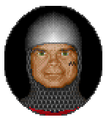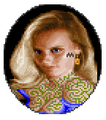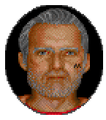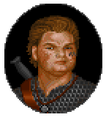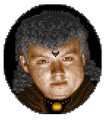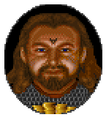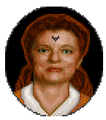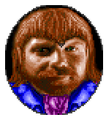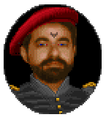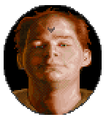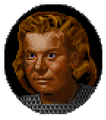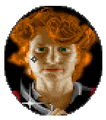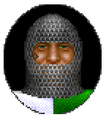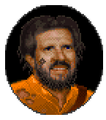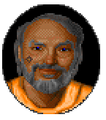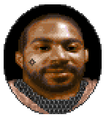Command
The Commands of Serpent Isle's Monitor are three competing factions among the knights of the city. They appear in Ultima VII Part Two.
Description[edit]
All Monitorian knights are affiliated with one of three Commands: the Bear Command, the Wolf Command, or the Leopard Command. Each of these groups has a single leader, and the government of Monitor is run such that the heads of the Commands take turns acting as Lord of the city, such that no single Command might maintain uncontested power over government. In addition to being named for a totemic animal, each Command is additionally characterized by a specific mark that is tattooed on the faces of its members, and each Command generally adheres to a specific military and political philosophy.
Although unwittingly, the Commands resemble the Order-Chaos-Balance scheme
Bear Command[edit]
The Bears favor a reliance on brute, physical strength as warriors and emphasize defense and fortification as long term martial strategies.[1] They are responsible for having erected with walls of Monitor, which were allegedly built to guard against the kidnapping of Monitorian children by goblin raiding parties, and they are credited with having routed Gurnordir's troops during his historic siege against the city.[2]
The mark given to knights of this Command is shaped like a smooth M and is tattooed on initiates' left cheeks. At the time of the Avatar's adventures on Serpent Isle, the leader of the Bears was Caladin, and the Command was responsible for the defense of a guard tower near the city of Fawn.
Members of the Bear Command included Caladin, Flicken, Luther, Lydia, Simon, Templar, and Wilfred. The Monitorian Knight Champion, Astrid, also hailed from this Command before her death, and it is probable that Groat, another deceased knight who had been a member of Astrid's patrol, did as well.
Leopard Command[edit]
The Leopards consider themselves the "peacemakers" of Monitor, striving to mediate the conflicts that occur between Monitor's three factions by attempting to bring the often conflicting Wolves and Bears into compromise and agreement.[3]
The mark given to knights of this Command is shaped like a cross between a V and a horned animal skull and is tattooed on initiates' foreheads. At the time of the Avatar's adventures on Serpent Isle, the leader of the Leopards was Marsten (although he may have been succeeded by Shazzana),[4] and the Command was responsible for the defense of a guard tower near Monitor itself.
Members of the Leopard Command included Marsten, Andral, Harnna, Shazzana, Spektor, and Standarr. Draygan, a prospector who could be found in an encampment in the Northern Forest also had once belonged to this Command, as had Flessar, a knight who had been killed on the List Field some time before the Avatar's arrival in the city.
Wolf Command[edit]
In contrast to the Bears, members of the Wolf Command typically prize dexterity and cunning in combat and endorse a political strategy advocating for the expansion of Monitorian influence to rest of Serpent Isle.[5] The Wolves were responsible for repairing the Serpent's Highway that crosses over the mainland and for erecting towers dedicated to the defense of non-Monitorian settlements. They more or less work beyond the walls of Monitor. Wolves are smart, preferring cunning over brute force. They are regarded as the friendliest of the Commands.
The mark given to knights of this Command is shaped like an empty diamond and is tattooed on initiates' right cheeks. At the time of the Avatar's adventures on Serpent Isle, the leader of the Leopards was Brendann, and the Command was responsible for the defense of a guard tower near the Inn of the Sleeping Bull.
Members of the Wolf Command included Brendann, Argus, Cellia, Johnson, Krayg, Lucilla, Renfry, and Shmed. During the course of Ultima VII Part Two, the Avatar would also join this Command.
Lore[edit]
| “ | Though still a warrior-based society, Monitor bears little resemblance to the Two Montors, its source cities. The town is quickly dividing into three clans: the Bear, Wolf and Leopard. Apparently all three seem to have retained their admiration of the principle of Courage, but their competition has reduced such a lofty aspiration to an object of trivial contention. Not even on the definition of Courage can they agree. There are plans to devise tests of mettle, though I expect there will be no cooperation to speed progress along. The coin used by the residents of Monitor is the Monetari.
Later note: The test was constructed. Despite my prediction to the contrary, all three factions worked in harmony to design this challenge. In more than two hundred years, the tenuous ties among the three have weakened remarkably little. However, the lines of division are still present. Members of each clan color their faces with tattoos symbolizing their totem animal. |
|---|
Trivia[edit]
- It is unclear as to how frequently Command leaders are supposed to alternate in taking on the title of Lord. According to Flicken, the Lord of Monitor changes with each new year.[6] Argus, however, indicates that all three Commands rule the city over the course of a year.[7]
- In the original plans, the three Commands were Bear (same), Panther (Leopard) and Bull (Wolf). That also would have made more sense for the Command manning the Bull Tower, since the Bulls became the Wolves during development. These animals were also intended to have more significance in the original plot.
References[edit]
- ↑ Caladin. Paul Carr’s Ultima transcripts. Ultima VII Part Two. "Bears, trainer".
- ↑ Templar. Paul Carr’s Ultima transcripts. Ultima VII Part Two. "forefathers, goblin artifacts".
- ↑ Marsten. Paul Carr’s Ultima transcripts. Ultima VII Part Two. "Leopards".
- ↑ Flicken. Paul Carr’s Ultima transcripts. Ultima VII Part Two. "Leopards".
- ↑ Brendann. Paul Carr’s Ultima transcripts. Ultima VII Part Two. "Serpent Isle, Wolves".
- ↑ Flicken. Paul Carr’s Ultima transcripts. Ultima VII Part Two. "ruler".
- ↑ Argus. Paul Carr’s Ultima transcripts. Ultima VII Part Two. "Monitor".


